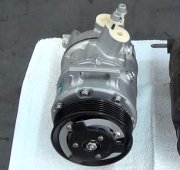First we have to know what was wrong with the radiator. Did it just start leaking slowly due to corrosion and age?
Running a compression test has nothing to do with the radiator itself, and there is no reason to perform a compression test unless there is a specific symptom or problem you are trying to diagnose.
The typical scenario for this type of story is the radiator is found to have a crack. Since most are made of plastic now, cracks can be expected, but an experienced mechanic will want to dig deeper to see if the damage occurred due to a previous crash, a badly-rusted body to include metal structural parts around the radiator, or, in this case, a leaking cylinder head gasket. If no other cause is found, a leaking cylinder head gasket might be a good suspect as that can put excessive pressure into the cooling system faster than the valve in the radiator cap can release it. The problem is though, a compression test is very likely not going to show that. Compression can be perfectly fine and the head gasket is still leaking. The proper test would be the "cylinder leakage test", but few shops have the tester for that. It takes a real lot longer to perform than a simple compression test. A compression test might show that compression is low. A cylinder leakage test will tell you why it is low. It involves forcing compressed air into one cylinder at a time, then observing in four places for where it is sneaking out. For the most common head gasket leaks, there will be a steady stream of tiny bubbles at the radiator cap.
To add to the confusion, a leaking radiator and a leaking cylinder head gasket can each cause the other one. If the head gasket corrodes through first, it can push combustion gas into the cooling system where the excessive pressure ruptures the radiator. Here is an article about performing the test for that:
https://www.2carpros.com/articles/head-gasket-blown-test
This is where your mechanic likely replaced the radiator, then he observed excessive pressure build-up, investigated further to find the leaking head gasket, and performed the compression test to verify his suspicion.
The radiator can also develop a leak that is slow enough that you do not notice right away the engine is running too hot. Cylinder heads and gaskets are up high on the engine, so they are the first things to overheat. A cylinder head can warp, causing a leak, or a marginal gasket that is due to fail in the next few months can have that failure hurried along by the overheating. This is where the leaking radiator can cause the leaking head gasket.
From your mechanic's point of view, a radiator can fail on its own without causing other problems. It is not uncommon for them to corrode through and leak. It is also pretty common for the cooling fins to corrode away. They will crumble away when you touch them. Because this is more common, it is customary to replace the radiator without performing other tests first. We would be wasting your money on a compression test probably 80 percent of the time. We would not do the compression test or the cylinder leakage test unless we found a reason to need them, and we will not see that reason until the radiator is replaced.
The better test for a cooling system leak is the pressure test, as described in this article:
https://www.2carpros.com/articles/radiator-pressure-test
In this test, the system is pumped up to 15 pounds of pressure, then we watch to see if that pressure drops, how quickly it drops, and we look for places it might be leaking. This would be much more appropriate than a compression test, but since it requires pressure to build up, it cannot be done with a cracked or leaking radiator. The radiator would have to be replaced first, then the cooling system is pressurized. If the pressure does not hold, and drops steadily, even over many minutes, that is when your mechanic would have looked further for the leakage. If that leakage is through the cylinder head gasket, coolant will fill one of the cylinders. The spark plugs would have to be removed to see which cylinder is filling up. No further testing would be needed at that point. The observation would be conclusive.
Thursday, October 25th, 2018 AT 6:35 PM



